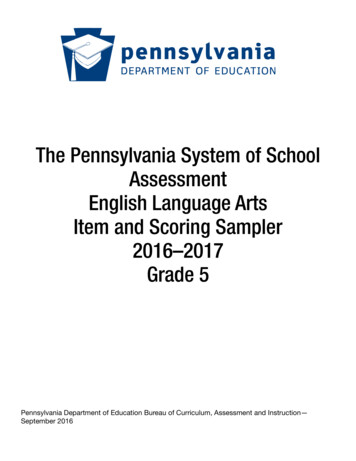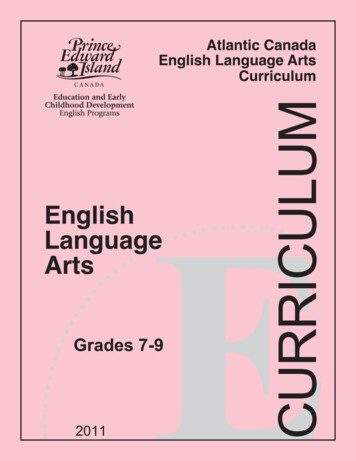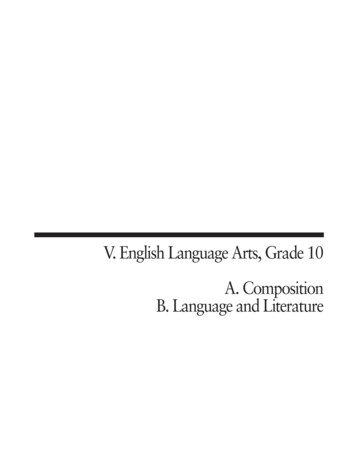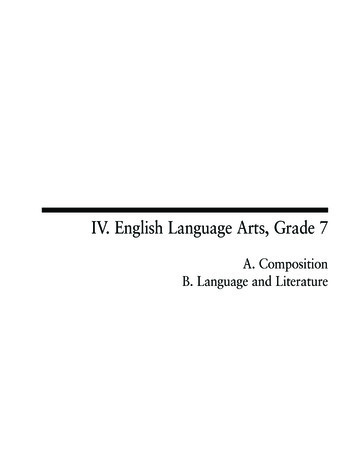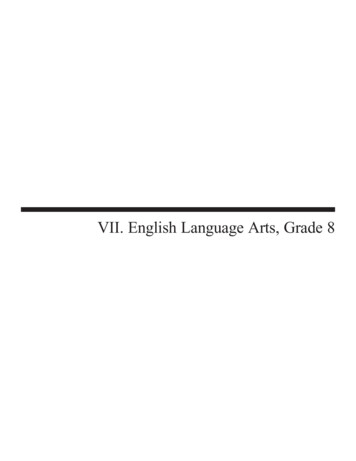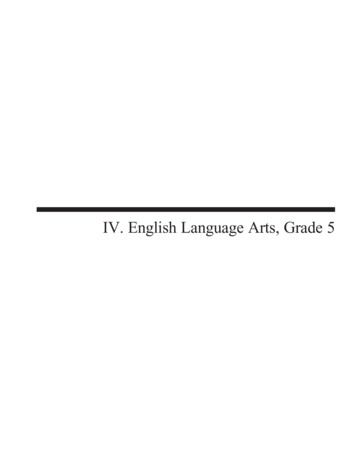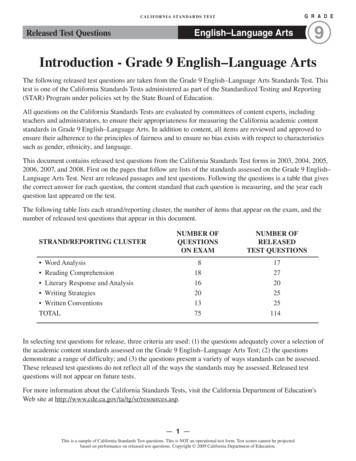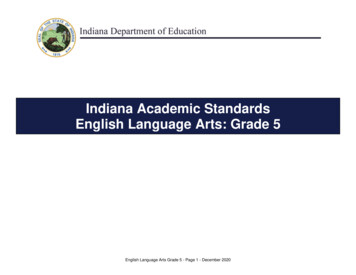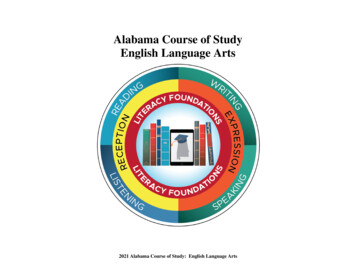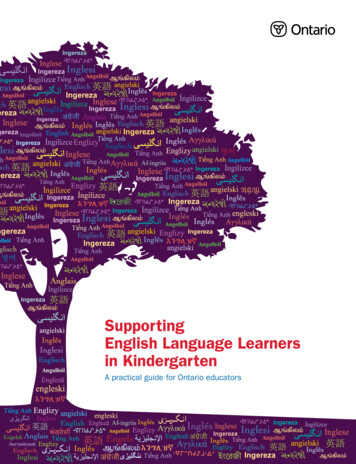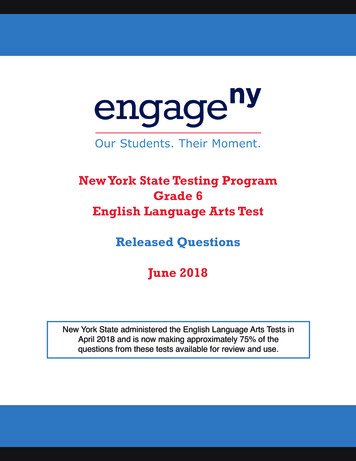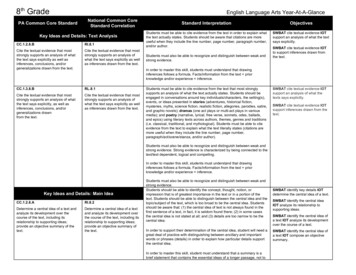
Transcription
th 8 GradePA Common Core StandardEnglish Language Arts Year At A GlanceNational Common CoreStandard CorrelationKey Ideas and Details: Text AnalysisCC.1.2.8.BRI.8.1Cite the textual evidence that moststrongly supports an analysis of whatthe text says explicitly as well asinferences, conclusions, and/orgeneralizations drawn from the text.Cite the textual evidence that moststrongly supports an analysis ofwhat the text says explicitly as wellas inferences drawn from the text.CC.1.3.8.BRL.8.1Cite the textual evidence that moststrongly supports an analysis of whatthe text says explicitly, as well asinferences, conclusions, and/orgeneralizations drawnfrom the text.Cite the textual evidence that moststrongly supports an analysis ofwhat the text says explicitly as wellas inferences drawn from the text.Standard InterpretationObjectivesStudents must be able to cite evidence from the text in order to explain whatthe text actually states. Students should be aware that citations are moreuseful when they include the line number, page number, paragraph number,and/or author.SWBAT cite textual evidence I OTsupport an analysis of what the textsays explicitly.Students must also be able to recognize and distinguish between weak andstrong evidence.SWBAT c ite textual evidence I OTto support inferences drawn fromthe text.In order to master this skill, students must understand that drawinginferences follows a formula. Facts/information from the text priorknowledge and/or experience inference.Students must be able to cite evidence from the text that most stronglysupports an analysis of what the text actually states. Students should beengaged in conversations around key individuals/characters, the setting(s),events, or ideas presented in s tories (adventures, historical fiction,mysteries, myths, science fiction, realistic fiction, allegories, parodies, satire,and graphic novels); d ramas (one act plays or multi act plays in variousmedia); and p oetry (narrative, lyrical, free verse, sonnets, odes, ballads,and epics) using literary texts across authors, themes, genres and traditions(i.e. classical, traditional, and mythological). Students must be able to citeevidence from the text to explain what the text literally states (citations aremore useful when they include the line number, page number,paragraph/act/scene/stanza, and/or author).SWBAT cite textual evidence I OTsupport an analysis of what thetexts says explicitly.SWBAT cite textual evidence I OTsupport inferences drawn from thetext.Students must also be able to recognize and distinguish between weak andstrong evidence. Strong evidence is characterized by being connected to thetext/text dependent, logical and compelling.In order to master this skill, students must understand that drawinginferences follows a formula. Facts/information from the text priorknowledge and/or experience inference.Key Ideas and Details: Main IdeaCC.1.2.8.ARI.8.2Determine a central idea of a text andanalyze its development over thecourse of the text, including itsrelationship to supporting ideas;provide an objective summary of thetext.Determine a central idea of a textand analyze its development overthe course of the text, including itsrelationship to supporting ideas;provide an objective summary ofthe text.Students must also be able to recognize and distinguish between weak andstrong evidence.Students should be able to identify the concept, thought, notion, orimpression that is of greatest importance in the text or in a portion of thetext. Students should be able to distinguish between the central idea and thetopic/subject of the text, which is too broad to be the central idea. Studentsshould be aware that: (1) the central idea of text is not always found in thefirst sentence of a text, in fact, it is seldom found there; (2) in some casesthe central idea is not stated at all; and (3) details are too narrow to be thecentral idea.In order to support their determination of the central idea, student will need agreat deal of practice with distinguishing between ancillary and importantwords or phrases (details) in order to explain how particular details supportthe central idea.In order to master this skill, student must understand that a summary is abrief statement that contains the essential ideas of a longer passage, not toSWBAT identify key details I OTdetermine the central idea of a text.SWBAT i dentify the central ideaIOT analyze its relationship tosupporting ideas.SWBAT i dentify the central idea ofa text IOT analyze its developmentover the course of a text.SWBAT identify the central idea ofa text IOT compose an objectivesummary.
be confused with a paraphrase, which is a restatement of the source text inabout the same number of words. Students are required to compose anobjective summary (without including their personal opinions and judgmentson the topic); doing so may be difficult for students because, for years, theyhave been asked to make text to self connections.Key Ideas and Details: ThemeCC.1.3.8.ARL.8.2Determine a theme or central idea of atext and analyze its development overthe course of the text, including itsrelationship to the characters, setting,and plot; provide an objective summaryof the text.Determine a theme or central ideaof a text and analyze itsdevelopment over the course ofthe text, including its relationship tothe characters, setting, and plot;provide an objective summary ofthe text.This standard represents an opportunity for students to determine andanalyze theme in a variety of fiction. Students should be able to identify theunifying or dominant idea(s) within a text. These central ideas or themes areusually represented as a common idea that appears throughout the text viakey details and events, or as a message or lesson to be taken from the text.Students will have to make inferences as the themes or central ideas will notbe explicitly stated in the text.Students should have the opportunity to explore the relationship betweenthe theme and other components of text, such as characters, setting, andplot. For example, theme will directly affect the actions or feelings of thecharacters, and/or the plot is directly shaped by the theme. In order tosupport theme development, students should compare and contrast howmajor themes are developed across the text and across multiple genres.Students should analyze how the theme(s)/central idea(s) is refinedthroughout the text.SWBAT identify key details I OTdetermine the theme or central ideaof a text.SWBAT i dentify the theme orcentral idea of a text I OT analyze itsdevelopment over the course of atext, including its relationship to thecharacters, setting, and plot.SWBAT identify the theme orcentral idea of a text I OT composean objective summary.Once the central idea has been determined, students will need to go back tothe text to identify specific details that help the central idea to emerge (getintroduced), shape (evolve), and get refined (become clearer/fullydeveloped).In order to master this skill, students must understand that a summary is abrief statement that contains the essential ideas of a longer passage, not tobe confused with a paraphrase, which is a restatement of the source text inabout the same number of words. Students are required to compose anobjective summary (without including their personal opinions and judgmentson the topic); doing so may be difficult for students because, for years, theyhave been asked to make text to self connections.Key Ideas and Details: Text AnalysisCC.1.2.8.CRI.8.3Analyze how a text makes connectionsamong and distinctions betweenindividuals, ideas, or events.Analyze how a text makesconnections among anddistinctions between individuals,ideas, or events (e.g., throughcomparisons, analogies, orcategories).Key Ideas and Details: Literary ElementsCC.1.3.8.CRL.8.3Analyze how particular lines ofdialogue or incidents in a story ordrama propel the action, reveal aspectsof a character, or provoke a decision.Analyze how particular lines ofdialogue or incidents in a story ordrama propel the action, revealaspects of a character, or provokea decision.This standard represents an opportunity for students to be exposed tohistorical text or text that has a focus on current social issues/topics.Students should have the opportunity to discuss: (1) how individualsinfluence individuals; (2) how individuals influence events; (3) howindividuals influence ideas; (4) how events influence individuals; (5) howevents influence ideas; (6) how events influence events; (7) how ideasinfluence individuals; (8) how ideas influence events; (9) how ideas influenceideasStudents must also be able to discuss the following terms: a nalyze to breakinto smaller components for the purpose of study or examination; a spect adistinct feature; incident an individual occurrence or event; p ropel todrive, or cause to move forward or onward; p rovoke to incite or stimulate toaction; and r eveal to disclose, unveil or tell.Students must be able to define and discuss the following elementsrelated to stories & dramas: Character a personality in a literary work Setting where the story takes place Plot t he pattern of events of a literary work, which includes: anexposition, rising action, climax, falling action, and resolutionSWBAT identify significantindividual, events, and ideas in atext IOT analyze how a text makesconnections among and distinctionsbetween individuals, ideas, orevents (through comparisons,analogies, and categories).SWBAT describe the relationshipsbetween key characters and eventsIOT analyze how particular lines ofdialogue or incidents in a story ordrama propel the action, revealaspects of a character, or provoke adecision.
Conflict t he struggle between opposing forces or ideas Theme u nifying or dominant ideaStudents must be able to define and discuss the following elementsrelated to dramas only: Scene a subdivision of an act of a play Act t he most major subdivision of a play; made up of scenes Dialogue c onversations between two or more persons/characters Stage Directions i nstructions for actors on and off stage Soliloquy a monologue in which the character is alone on stage, orbelieves they are alone, and reveals their innermost feelings or thoughts Aside a part of an actor's lines supposedly not heard by others on thestage and intended only for the audience Dramatic irony the audience has information that the characters onthe stage do not possess; used to create suspense Monologue a long speech delivered by one character on stageCraft and Structure: VocabularyCC.1.2.8.FAnalyze the influence of the words andphrases in a text including figurativeand connotative, and technicalmeanings; and how they shapemeaning and tone.CC.1.3.8.FAnalyze the influence of the words andphrases in a text including figurativeand connotative meanings; and howthey shape meaning and tone.RI.8.4Determine the meaning of wordsand phrases as they are used in atext, including figurative,connotative, and technicalmeanings; analyze the impact ofspecific word choices on meaningand tone, including analogies orallusions to other texts.RL.8.4Determine the meaning of wordsand phrases as they are used in atext, including figurative andconnotative meanings; analyze theimpact of specific word choices onmeaning and tone, includinganalogies or allusions to othertexts.Students must be required to use their conceptual understanding of each ofthe terms above to connect d ialogue (from stories or dramas) and/orincidents (from stories or dramas) to actions of the characters, revelationsabout their character traits, and decisions they made throughout the courseof the story or drama.97% percent of the words that students will encounter when they read aremade up of 30 prefixes, 30 roots, and 30 suffixes. 70% of the wordsstudents will encounter can be defined using word parts and 30% can bedefined using context clues.Determining the meaning of phrases is a critical skill with implications for alllater grades and disciplines.97% percent of the words that students will encounter when they read aremade up of 30 prefixes, 30 roots, and 30 suffixes (including figurative,connotative, and technical words). 70% of the words students will encountercan be defined using word parts and 30% can be defined using contextclues.Determining the meaning of phrases is a critical skill with implications for alllater grades and disciplines.Students must identify literal (exact or actual) meaning to understanddenotation and nonliteral (figurative or symbolic) meaning to understandword connotation. Students should focus on figurative language (e.g.,metaphors, similes, hyperboles, personification, onomatopoeia, etc.) in orderto understand how such language provides depth (understanding that toneis directly related or tied to connotation) and meaning to texts.Students should be aware that the words an author uses tocommunicate/tell a story have a tone (attitude) and that an authorintentionally chooses his/her words to fulfill his/her purpose for writingincluding his/her attitude toward the subject of the text. The collection ofwords that an author uses to communicate/tell a story have an impact on thereader’s beliefs and/or actions.Students should have an opportunity to assess how analogies (comparisonsSWBAT identify and define wordparts IOT determine the meaning ofunfamiliar words and phrases(including figurative, connotative,and technical meanings).SWBAT i dentify context clues I OTdetermine the meaning ofunfamiliar words and phrases(including figurative, connotative,and technical meanings).SWBAT a nalyze word choice I OTweigh the impact of specific wordchoice on meaning and tone.SWBAT a nalyze word choice IOTdetermine the impact of specificwords on meaning and tone(including analogies or allusions).
like metaphors and similes) and allusions (references) to other texts impactmeaning and tone as well.Craft and Structure: Text StructureCC.1.2.8.ERI.8.5Analyze the structure of the textthrough evaluation of the author’s useof specific sentences and paragraphsto develop and refine a concept.Analyze in detail the structure of aspecific paragraph in a text,including the role of particularsentences in developing andrefining a key concept.CC.1.3.8.ERL.8.5Compare and contrast the structure oftwo or more texts and analyze how thediffering structure of each textcontributes to its meaning and style.Compare and contrast thestructure of two or more texts andanalyze how the differing structureof each text contributes to itsmeaning and style.There are 6 text structures that students must know. It is important forstudents to know that the author’s purpose is directly linked to the textstructure that the author chooses to develop ideas. The six text structuresare as follows:1. A text written using the descriptive text structure describeswhat a person, place, thing or idea is like.2. In texts organized under the compare/contrast text structure,the author explains how two or more persons, places, things,or ideas are alike and/or how they are different.3. Chronological order refers to the presentation of informationaccording to the progress of time (times, dates, years, etc.)All chronologies are sequential, but not vice versa.4. Sequential order refers to the presentation of informationsuch as events or steps in the order that they occurred orshould occur (without the use of time). Instructions, recipes,directions, and scientific experiments are types of texts thatare often written in sequential order.5. Texts written using the cause and effect text structuredescribe event(s) and tell the reader what happens as adirect result (effect) of the event(s). The cause is the eventthat serves as the reason for the effect. The effect is theconsequence or result of the cause.6. A text written using the problem/solution text structurepresents a problem and includes information about how itcan be or has been solved. It includes a problem: a situation,matter, or person that presents a challenge or struggle and asolution: the answer or possible answer to the challenge orstruggle.SWBAT name and recognize thesix text structures IOT analyze thestructure of a specific paragraph ina text, including the role ofparticular sentences in developingand refining a key concept.Students will need to be able to identify specific structural elements ofdrama (e.g., monologues, soliloquies, dialogues, etc.), poetry (odes,sonnets, ballads, free verse, etc.), or narrative/prose (exposition, risingaction, climax, falling action, resolution) and connect them to the author’sintention. For example, students will note that a soliloquy is intentionallyused by the author to relay inner thought to the audience to advance the plotor support a theme, and an ode will be used when an author’s purpose is tohonor a person or a thing. To compare these two structures, a student maynote that a soliloquy is similar in structure to poetry. Another example is thata student should notice that dramas and prose will follow a narrativestructure. However, drama will utilize dialogue to tell the story while prosewill use paragraphs to tell the story.SWBAT compare and contrast thestructure of two or more texts IOTanalyze how the differing structureof each text contributes to meaningand style.Once students have identified the differences in the structures of texts, theywill analyze how those structures contribute to the overall meaning and styleof each text. Students must understand that an author’s choice of structurein literature aligns with their purpose for writing. That purpose could be to tellevents, relay a theme, emotion, or description. This standard asks thatstudents determine whether the use of these elements creates a style, suchas a tone of mystery or elements of suspense and surprise, in order toanalyze how structure enhances the plot or theme of the story, poem, ordrama.
Craft and Structure: Point of ViewCC.1.2.8.DRI.8.6Determine an author’s point of view orpurpose in a text and analyze how theauthor acknowledges and responds toconflicting evidence or viewpoints.Determine an author’s point ofview or purpose in a text andanalyze how the authoracknowledges and responds toconflicting evidence or viewpoints.CC.1.3.8.DRL.8.6Analyze how differences in the pointsof view of the characters and theaudience or reader (e.g., createdthrough the use of dramatic irony)create such effects as suspense orhumor.Analyze how differences in thepoints of view of the charactersand the audience or reader (e.g.,created through the use ofdramatic irony) create such effectsas suspense or humor.Integration of Knowledge and Ideas: Diverse MediaCC.1.2.8.GEvaluate the advantages anddisadvantages of using differentmediums (e.g., print or digital text,video, multimedia) to present aparticular topic or idea.RI.8.7Evaluate the advantages anddisadvantages of using differentmediums (e.g., print or digital text,video, multimedia) to present aparticular topic or idea.Integration of Knowledge and Ideas: Sources ofInformationC.C.1.3.8.GAnalyze the extent to which a filmed orlive production of a story or dramastays faithful to or departs from the textor script, evaluating the choices madeby directors or actors.RL.8.7Analyze the extent to which afilmed or live production of a storyor drama stays faithful to ordeparts from the text or script,evaluating the choices made bythe director or actors.This standard requires that students determine the author’s point of view(opinion or perspective) on a particular topic. This standard also requiresthat students are able to answer the question, “Why did the author composethe text?” The three former purposes for writing: to persuade, entertain, andinform, are no longer sufficient to answer this question. They have beenreplaced with informative, explanatory, and argumentative.The most useful author’s purpose questions are open ended and requirestudents to refer to the text to support their determination of the author’spoint of view or purpose. Students must also recognize/note how an authoracknowledges and responds to evidence or viewpoints (opinions) differentfrom his/her own.SWBAT determine the author’spoint of view and purpose I OTanalyze how the authoracknowledges and responds toconflicting evidence or viewpoints.The chosen point of view will develop the characters and events throughouta text by revealing individual perspectives. The students are responsible foridentifying the specific point of view from which the story is told and be ableto track how the perspectives are developed as the story unfolds.SWBAT identify the point of view ofcharacters I OT analyze howdifferences in the points of view ofthe characters and the audience orreader create such effects assuspense or humor.Students must compare and contrast the different points of view of differentcharacters or narrators of a text to gain deeper meaning related to the plotor theme of the story. Depending on which point of view the author writesfrom (First Person, Third Person, or Third Person Omniscient), certaineffects can be achieved that will affect the perspective of the reader. Forexample, an author can easily create dramatic irony through the use of aFirst or Third Person perspective, but can not do so if writing from a ThirdPerson Omniscient point of view.This standard requires that students read a text and view or listen to anotherversion of the same text in order to note similarities and differences betweenboth medium’s presentation of information on the subject of the text.Students must also evaluate the effectiveness of the use of one mediumover another to present information on the subject of the text, in the contextof the fulfillment of the author’s purpose.This standard represents an opportunity for students to see a story or dramain other representations. Students must be provided the opportunity to reada text, then provided an opportunity to experience the same text in a filmedor live version. Students must be able to compare and contrast what they“see” and “hear” when reading the text to what is shown, heard, or perceivedwhen they listen to or watch a different version. Students should beencouraged to participate in discussion about the differences in order toexperience multiple perspectives. Students should be able to pinpointcertain techniques that bring the story to life when presented visually ororally and explain how those techniques emphasize or differ from the writtenimagery contained in the text.SWBAT identify the mediums usedto present information on a giventopic or idea I OT evaluate theadvantages and disadvantages ofusing different mediums to presentthe topic or idea.SWBAT analyze the extent towhich a filmed or live production ofa story or drama stays faithful to ordeparts from the text or script IOTevaluate the choices made by thedirector or actors.Students will understand that the creator of the interpretation (author,director, actor, etc.) may use creative license to represent the same story ina new or different way. Students will weigh the contrasts and similarities inthese interpretations and determine the value of the choices made in eachversion.Integration of Knowledge and Ideas: EvaluatingArgumentsThis standard requires that students read texts wherein an author iscommunicating an argument on a particular topic. Students must be givenan opportunity to determine the author’s argument/opinion on a topic,SWBAT delineate and evaluate theargument and specific claims in textIOT assess whether the reasoningis sound and the evidence is
CC.1.2.8.HEvaluate authors’ arguments,reasoning, and specific claims for thesoundness of the arguments and therelevance of the evidence.RI.8.8Delineate and evaluate theargument and specific claims in atext, assessing whether thereasoning is sound and theevidence is relevant and sufficient;recognize when irrelevantevidence is introduced.followed by (1) an opportunity to identify the specific claims the authormakes; (2) attribute reasons and evidence to a particular claim; (3)identifying claims that are not supported by relevant reasons and evidence;and (4) assessing the relevance and strength of the evidence used tosupport each additional claim.relevant and sufficient to supportthe claims.SWBAT delineate and evaluate theargument and specific claims in textIOT recognize when irrelevantevidence is introduced.RL.8.8Not Applicable to LiteratureNot Applicable to LiteratureIntegration of Knowledge and Ideas: Analysis AcrossTextsCC.1.2.8.IAnalyze two or more texts that provideconflicting information on the sametopic and identify where the textsdisagree on matters of fact orinterpretation.RI.8.9Analyze a case in which two ormore texts provide conflictinginformation on the same topic andidentify where the texts disagreeon matters of fact or interpretation.Integration of Knowledge and Ideas: Text AnalysisCC.1.3.8.HAnalyze how a modern work of fictiondraws on themes, patterns of events,or character types from traditionalworks, including describing how thematerial is rendered new.RL.8.9Analyze how a modern work offiction draws on themes, patternsof events, or character types frommyths, traditional stories, orreligious works such as the Bible,including describing how thematerial is rendered new.This standard requires that students read two pieces of text on the sametopic written by different authors, noting differences in the information theypresent (where they disagree in matters of fact interpretation). The importantlesson that students should learn from this standard is the notion thatauthors often include or omit evidence/interpretation of facts to support theirown purpose for writing/individual bias.This standard requires that students understand how modern orcontemporary texts are influenced by traditional texts, including myths andreligious works. Students must use their knowledge of traditional literature incombination with excerpts or passages from that traditional work in order tolocate elements of or allusions to that work in a modern text. They must thenanalyze how the traditional material has been altered in the contemporarypiece in order to fit or appeal to a modern audience. For example, theGoddess Test, a contemporary piece, draws on elements from the myth ofPersephone.SWBAT analyze a case in which 2or more texts on the same topicprovide conflicting information I OTidentify where the texts disagree onmatters of fact or interpretation.SWBAT a nalyze how a modernwork of fiction draws in themes,patterns of events, or charactertypes from myths, traditionalstories, or religious works such asthe Bible I OT describe how thematerials is rendered new.
PA Common CoreStandardNational Common CoreStandard CorrelationStandard InterpretationThrough modeled, guided, and independent writing, students will learn to:Writing : Informative & ExplanatoryCC.1.4.8.AWrite informative/explanatory textsto examine a topic and conveyideas, concepts, andinformation clearly.Focus: CC.1.4.8.BIdentify and introduce the topicclearly, including a preview ofwhat is to follow.Content: CC.1.4.8.CDevelop and analyze the topic withrelevant, well chosen facts,definitions, concrete details,quotations, or otherinformation and examples;include graphics andmultimedia when useful toaiding comprehension.Organization: CC.1.4.8.DOrganize ideas, concepts, andinformation into broadercategories; use appropriateand varied transitions to createcohesion and clarify therelationships among ideas andconcepts; provide a concludingstatement or section; includeformatting when useful toaiding comprehension.Style: CC.1.4.8.EWrite with an awareness of thestylistic aspects ofcomposition. Use preciselanguage and domain specificvocabulary to inform about orexplain the topic. Usesentences of varying lengthsand complexities. Create toneand voice through preciselanguage. Establish andmaintain a formal style.Conventions: CC.1.4.8.FDemonstrate agrade appropriate command ofthe conventions of standardEnglish grammar, usage,capitalization, punctuation, andspelling.CC.W.8 . 2Write informative/explanatory texts toexamine a topic and convey ideas,concepts, and information through theselection, organization, and analysis ofrelevant content. Introduce a topic for the intended audience; organize ideas,concepts, and information using strategies such as definition,classification, comparison/contrast, and cause/effect to supportthe writer’s purpose. Develop the topic with relevant facts, definitions, concrete details,quotations, or other information and examples. Use appropriate transitions to clarify the relationships amongideas and concepts. Use precise language and domain specific vocabulary to informabout or explain the topic. Establish and maintain a formal style. Provide a concluding section that follows from the information orexplanation presented.Sample genres include: essays, recipes, a description of an historical event,a scientific experiment, and research reports.ObjectivesSWBAT understand the elementsof writing (focus, content ,etc.) IOTcompose a piece of informationalor explanatory text with anintroduction, supporting facts,definitions and details, and aconcluding statement or section.SWBAT group related informationtogether within and acrosscategories of information and usegrade appropriate conventions oflanguage I OT communicate writteninformation clearly.
Writing : NarrativeCC.1.4.8.MWrite narratives to develop real orimagined experiences or events.Focus: CC.1.4.8.NEngage and orient the reader byestablishing a context and point ofview and introducing a narratorand/or characters.Content: CC.1.4.8.OUse narrative techniques such asdialogue, description, reflection,and pacing to develop experiences,events, and/or characters; useprecise words and phrases,relevant descriptive details, andsensory language to capture theaction and convey experiences andevents.Organization: CC.1.4.8.POrganize an event sequence thatunfolds naturally and
8 th Grade English Language Arts Year At A Glance PA Common Core Standard National Common Core Standard Correlation Standard Interpretation Objectives Key Ideas and Details: Text Analysis
